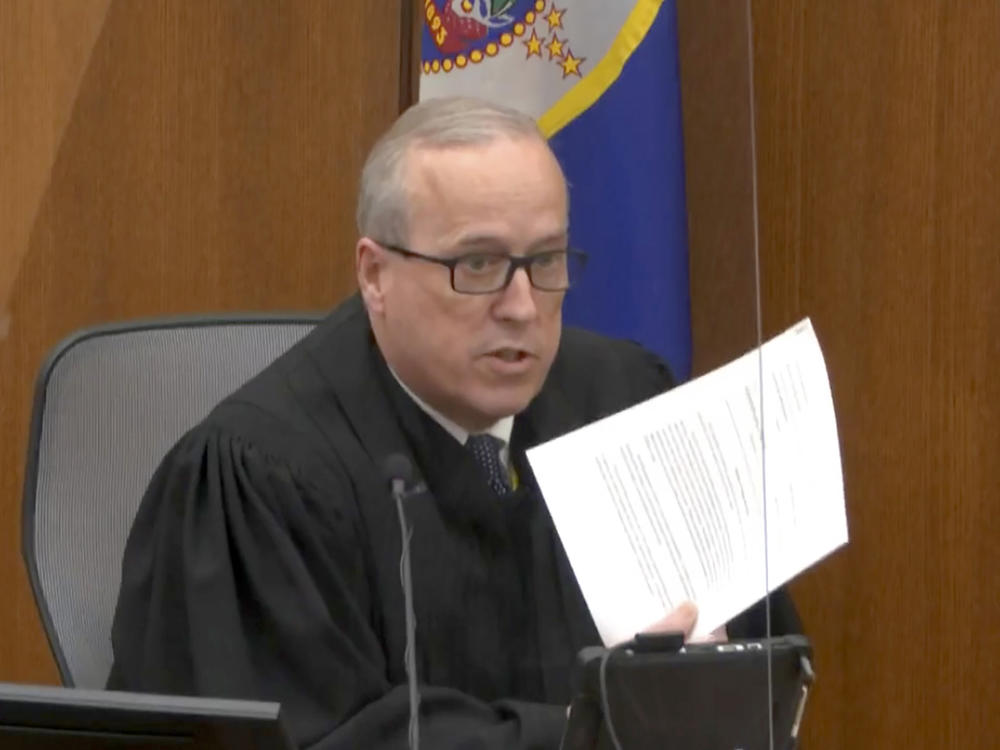Section Branding
Header Content
Trial Of Derek Chauvin In The Death Of George Floyd Goes To The Jury
Primary Content
The fate of former Minneapolis police officer Derek Chauvin, on trial for the killing of George Floyd in May 2020, is now in the hands of the jury.
Chauvin's trial entered its seventh week Monday with Hennepin County Judge Peter Cahill's instructions to jury members, followed by closing arguments from prosecution and defense attorneys. Jurors will be sequestered during their deliberations.
In closing arguments, prosecutor Steve Schleicher said Chauvin directly caused the death of Floyd on Memorial Day after kneeling on Floyd's neck for 9 minutes and 29 seconds.
"He did what he did on purpose, and it killed George Floyd," Schleicher stressed. He rebutted arguments made by the defense that other factors contributed to Floyd's death, such as his narrowed arteries, drug use and possible carbon monoxide poisoning from a nearby car tailpipe.
"Use your common sense. Believe your eyes. What you saw, you saw," he said, referring to video of the encounter between Chauvin and Floyd. And countering defense testimony during the trial, Schleicher said that Chauvin's use of force was not reasonable and was contrary to his police training.
Defense attorney Eric Nelson in his closing argument focused on how "a reasonable police officer" would have handled the situation.
"A reasonable officer would understand this situation," Nelson said, "that Mr. Floyd was able to overcome the efforts of three police officers while handcuffed, with his legs and his body strength."
None of the use-of-force experts said anything that happened up to the moment that Floyd was put on the ground was contrary to police training and tactics or was unreasonable, Nelson said. He argued that Chauvin holding Floyd to the ground should not be seen outside the context of what preceded it.
Chauvin faces three counts: second-degree murder — unintentional; third-degree murder; and second-degree manslaughter. Cahill's instructions to the jury focused on the elements of each count that must be met to reach a guilty verdict according to Minnesota state law.
Here are the highlights of Cahill's instructions:
Second degree murder — unintentional is defined as causing death without intent to do so, while committing or attempting to commit a felony offense. Chauvin's alleged felony is assault in the third degree: the infliction — or attempted infliction — of substantial bodily harm upon another by using unlawful force.
Cahill said it is not necessary for the state to prove that Chauvin intended to inflict substantial bodily harm on Floyd "or knew that his actions would." The prosecution must prove only that Chauvin "intended to commit the assault and that George Floyd sustained substantial bodily harm as a result." The charge carries a maximum sentence of 40 years.
Third-degree murder is defined as causing death to an individual by "perpetrating an act imminently dangerous to others and evidencing a depraved mind without regard for human life" but without the intent to cause death, the judge said. To be found guilty, the jury must find that the defendant acted with "reckless disregard" for human life, he said. The maximum sentence for this charge is 25 years.
Second-degree manslaughter is causing the death of another by "culpable negligence, creating an unreasonable risk" in which the defendant "consciously takes the risk of causing death or great bodily harm to another individual."
Cahill said that an unreasonable risk would be understood to be so by an "ordinary and reasonably prudent" individual. The charge carries a maximum sentence of 10 years.
Copyright 2021 NPR. To see more, visit https://www.npr.org.

